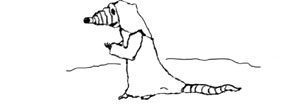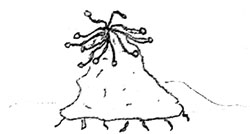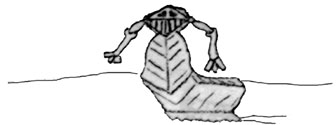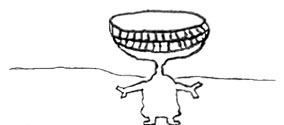
This game is intended to be a celebration of life in all its various manifestations. Players take the parts of aliens aboard a mixed-species trading ship, plying its way between the worlds of a vast and somewhat anarchic interstellar empire. Your mission - to explore the galaxy, to encounter strange new life-forms and sell things to them, to boldly fleegle where no alien has fleegled before!
Of course, with so many species developing on so many different worlds, the interactions between them are likely to be rather - well - odd, and it's with these interactions that the game will be largely concerned. The style will no doubt develop as play proceeds but what I have in mind is a combination of the background of C.J. Cherryh's Chanur books, the action of Star Wars, the technological efficiency of Paranoia and the game mechanics of Ghostbusters. No doubt unsubtle parodies of well-known SF books and films will creep in as well. The nearest equivalent I can think of is that comic book Shelagh's got called "Buck Godot - Zap Gun for Hire". And, of course, because it's one of my creations, there'll be no weirdness whatsoever. No way, no how. Those who have played in my Ghostbusters campaign will have some idea of what to expect...
The Lalgoozian Dominion, where the game is set, is an empire only in the loosest possible sense of the word. The Lalgoozians, an insectoid race shaped like the back end of scorpion with two big bulging eyes at the top, have a curious philosophy in which the important thing is that you own something rather than actually use it. Perhaps because of this worldview, they were the first aliens to develop space travel, and promptly set out to conquer the universe. "Conquering" consisted of landing on an inhabitable planet, sticking a flag into the ground, building a guardtower and landing pad, setting a couple of guards and flying off again. And that was it. The guards did not interfere in any way with the rest of the world, except if something tried to mess with the flag in which case they vaporised it with their deadly plasma cannons. Creatures with rather less abstract notions of ownership would occasionally kill the guards and tear down the flag, in which case the Lalgoozians would return, blast the perpetrators and several square kilometres of the surrounding countryside from space, settle on the rubble and set up a new base with flag, then take off again. Most sentient creatures have learnt to let the Lalgoozians have their bit of land. Those that survived, that is.
No one is quite sure why the Lalgoozians want to own the universe; they don't trade with anyone except when absolutely necessary (the guards are supplied once every fifty years or so from Lalgooz) and they fry anyone who tries to visit the motherworld (some alien philosophers suspect a religion whose final event is "the great stock-taking"). Their technology is unique in that it has never been known to malfunction and thus they are justly feared. The effect of their presence is that a) aliens at war with one another have to be careful not to touch the flag (the Lalgoozians always seem to know who the offending species is and take their revenge on its planet) which has limited interplanetary conflict, and b) Lalgoozian currency is the only one accepted throughout the galaxy. Unfortunately, the Lalgoozians trade so rarely that one Lalgoozian frip will buy a small planet, and thus barter is the main form of trade. The Lalgoozians are regarded by the majority of species as the most boring bastards in the galaxy (yes, they're even coloured grey). Curiously, the only known inhabitable planet that they haven't settled on is Earth...
Well, strictly that should be the Galactic "Government" as the Lalgoozians haven't the slightest interest in administering the territories they own. The inhabitants of LAL 14, the nearest space station to the Lalgoozian mother world that the Lalgoozians will permit, do however regard themselves as the Galactic Government for the simple reason that most communication between the Lalgoozians and the rest of the universe is done through them. LAL 14 is also the place where the minimal amount of trade between Lalgooz and its empire occurs and it didn't take long for the Government to hit on the idea of taxing all the transactions to the hilt. The result is that the Galactic Government (henceforth known as GG) is extremely rich (it is rumoured to have as many as 100 frips). This doesn't stop it from attempting to levy taxes on anything that moves1 and issuing obscure and bureaucratic decrees at regular intervals. Unfortunately for traders, these mostly affect trade since it's about the only thing that it can control. The GG is regarded with suspicion and contempt throughout the Lalgoozian Dominions but its decrees are occasionally backed up by deadly and efficient Lalgoozian battle cruisers, and thus ignoring them is not always a good survival strategy. The Prime Directive (see below) is particularly strongly enforced.
The classic evolutionary pathway for the development of a species from primitive planet-dweller to sophisticated alien-about-galaxy can be divided into four initial phases: 1) first contact with an alien race (normally the Lalgoozians planting a flag), 2) resultant rapid development of space technology (or, in the case of really primitive planet-dwellers, vehicles capable of travelling upwards), 3) contact with neighbours who have also just developed space travel, and 4) major interplanetary war. Assuming that the species survives these four phases, it can then move on to phase 5), interplanetary trade, which is just as expensive as war but less bloody (normally).
As trade took off in a big way, the earliest alien traders soon realised that someone was going to have to impose a modicum of order. With a dozen alien species all competing for the same space station docking sites, pitched battles were inevitable and frequent. They appealed to the GG, who responded by setting up a Department of Interplanetary Trade and Exchange (DITE) with local offices on a number of the more prominent planets and space stations. This was a typical government Department stuffed with bored bureaucrats, and although they stopped the fights and sorted out most of the trading arrangements, they got up the noses or similar orifices of the alien traders in no uncertain terms. These early traders got on rather well, in fact, largely as a result of natural selection (in the form of laser-wielding alien races expressing their "consumer resistance") weeding out those who wouldn't co-operate with each other. And all the messages between DITE local offices and LAL 14 were carried by traders...
The result was the most subtle coup in history. The traders charged such high carriage rates for replacement bureaucrats (and ignored laws demanding that they carry them for free) that the GG instituted a policy of local recruitment for DITE offices. For reasons which are still not entirely clear2, the new recruits turned out to consist largely of ex-traders. Somehow, this information failed to reach DITE central. Eventually some of these new recruits were promoted to the GG itself, and instituted directives which benefited traders immensely. And thus was the Guild born.
The Guild is still officially known as the DITE and is the main instrument through which the GG tries to implement its directives concerning trade. Traders, however, see it as a source of services, information and training, staffed (generally) by trader-sympathetic officials. A good Guild centre provides basic training in the more common spaceship skills, sets standards for hygiene and safety aboard merchant ships, arbitrates in trading disputes, runs an information service on available spaceship positions and potential markets, and provides rest and relaxation facilities where members with money can have a good time.
However, being (ostensibly) an arm of the GG does mean that the Guild has its irritating points. The most controversial thing it does is to grade all trading ships into five classes, with class 1 ships being the sort that would carry a Lalgoozian diplomat (if such a being were to exist) and class 5 ships being regarded as the intergalactic equivalent of the dodgy insurance salesman. No captain of a non-class 1 ship considers the grade assignment scheme to be fair, but the Guild has managed to prevent all-out rebellion by promoting ships to higher grades "when their trading record justifies it". The exact criteria for promotion remain a closely guarded secret among Guild officials.
Over the years a number of well-plied space routes have developed, mostly in two great loops from Lalgooz known as the Zoovoo and Ec'coc circles (after the legendary traders who first navigated them). The planets linked by the Circles have become known as the Eighteen Worlds, and are the most well-serviced by the Guild. They are also the most dominated by the GG. Rewards tend to be lower for trade between the Eighteen Worlds as there is so much competition, but at least the tasks assigned are safe (generally). Out in the wilder, less charted areas at the edges of the circles the rewards can be greater but so are the risks. Cowardly (or prudent) aliens stick to the Circles.
The chief form of space travel is ye good olde Asimovian hyperspatial jump, which is the only means of FTL travel available under the laws of physics observed by the majority of species (I propose to ignore the laws of relativity that say that FTL travel should make you go backwards in time...). To carry out such a jump, you need a) a spaceship capable of reaching four fifths lightspeed, b) a working set of hyperspatial field generators (the Hniffni of Thau Beta make the cheapest but also the most eccentric), c) a space free of large masses to jump from and d) some idea of where you're going. Some aliens may also need to take drugs to cope with the mental stress of having their cognitive (and, for that matter, generative) organs folded in directions in which they were never intended to go. Your final destination depends on the direction in which you were travelling when you made the jump and the disposition of masses along your route; thus having a coherent navigator and a good set of star maps is essential. Most standard jumps can be carried out by a computer (if you can afford one), the problem being that computers complicated enough to be of any use tend to develop their own personalities...
Hyperspatial generators work by blasting a hole in conventional spacetime; this requires an enormous amount of energy and thus spaceships must be regularly refuelled after jumps. Different space ships use different fuels of which hydrogen is the most common. The larger the mass the spaceship is carrying, the more fuel is used in jumping.
[Note: Any and all technologies are subject to change; if anyone can come up with a better (and, more importantly, funnier) technology, spaceship function may undergo a rapid and remarkable transformation...]
Languages are the chief reason for the multi-species nature of most merchant ships. What with some 40 known inhabited worlds and 60 sentient species all employing one or more auditory, visual, olfactory or tactile languages, inter-alien communication is a real problem. The GG has of course come up with a solution, an invented language called Pan-Galactic which can in principle be used by any species capable of making five different recognisable signals, but it is so cumbersome in use (the sentence "I want a banana" translates as "aeiou aii iuouii uii ioeauuii", where each letter is pronounced separately) that only GG officials use it. The Xerendira of Fewtha-Oc, small hairy pyramid-shaped aliens with big clawed feet, will translate most of the major languages of the Eighteen Worlds but a) cost a vast amount to hire (you need at least two, as a xerinderon will only translate one way), and b) have an irritating habit of perching on a shoulder or any other flat surface that their employer should happen to possess3.
To overcome this problem, captains of inter-system trading ships have taken to hiring mixed species crew so that there is at least the chance that someone on the ship will be able to communicate with the natives. Not unnaturally this creates some problems for spaceship design and management (the toilet, for instance, is generally the largest room in the ship), but having a crew member who can tell you that the native who is smiling at you is just about to use her tail-cannon to blow you away is a definite survival advantage.
There is one other language which is generally known throughout the Dominion and that is the Earthling language English. This is due to the popularity of Earthling soap operas (see below).
Although the Lalgoozians are generally pretty laissez-faire about the activities of their subjects, there is one law that they enforce with extreme vigour. Known as the Prime Directive, it runs as follows:
Thou shalt not let the Earthlings know that aliens exist.
All electromagnetic radiations and hyperspatial generators must be shielded to prevent the Earthlings from working out that the galaxy is crawling with aliens. Fortunately, Earthling radio telescopes are so primitive that this is not difficult.
No-one knows why the Lalgoozians enforce this strange directive. Various suggestions have been made; perhaps the Lalgoozians are afraid that if notified of their existence the Earthlings will rapidly develop space travel and invade the Dominion (this idea is not taken seriously), perhaps Earth is a Lalgoozian experiment, perhaps some great Lalgoozian secret is hidden there. Whatever the reason, the result has been that electromagnetic emanations from Earth have been intensively studied and are widely diseminated around the galaxy. In particular, the continuing series known as "soap operas" have a wide following, though needless to say the majority of aliens don't understand them at all.

Description: Small, rat-like creatures with wrinkled snouts protuding from shapeless clothing.
Home Planet: Thau Beta.
Characteristics: Ubiquitous in the Dominions, they speak and behave like door-to-door salesmen. Given to using perfumes to disguise their basically unpleasant odour, which (of course) makes them smell worse to some aliens. You must never remove their hoods, which conceal something horrible. Suppliers of cheap but dodgy ship parts.

Description: Pyramid-shaped creatures with a bundle of bulbous tentacles at the top end.
Home Planet: Glau'glooc
Characteristics: Tch-n'k-nik-teeg roughly translates (in the local Jik'nol dialect) as "creatures with the stupid antennae on their heads". Completely insensitive to sounds, these aliens communicate by means of bobbles on the ends of their tentacles which light up in different patterns of pretty colours. Unfortunately, this is the only form of communication that the Tch-n'k-nik-teeg recognise. An artificial tentacle set has however been developed by the Veshkavian of Talnuk 4, a race that has experimented with translation devices that pick up electrical signals, chemical secretions etc. directly. So all you have to do to trade with the Tch-n'k-nik-teeg for their well-made and popular goods is to put a set on your head or other command organ. There is a small drawback, however; wearers can end up inadvertantly broadcasting their innermost thoughts to the Tch-n'k-nik-teeg.

Description: Worm-like, with a triangular cross-section segmented body bent up at the front and a grill-like mouth in a pyramidal head. Two arms, emerging from where the ears should be.
Home Planet: Quevern
Characteristics: These aliens are incapable of saying the letter "s", which they pronounce as "v". They make a constant "Vvvvv Vvvvv..." sound. Ubiquitous on LAL 14, the H'veev are a law-obsessed bureaucratic race which are perfectly suited for their roles as minor officials of the GG. If a H'veev decides that it wants to inspect your ship, you are in trouble.

Description: Small black slugs with tentacles and pyramidal white traffic cones on their backs.
Home Planet: Vesclop
Characteristics: A vicious militaristic race which has earned the emnity of all its neighbours. A merdon's cone is made of merdite, the most indestructible material in the galaxy; thus a merdon is very hard to kill as its vital organs are stored in it. The merdi are the Dominion's chief weapons manufacturers, though trading with them is a tricky business; they have a slave moon (Chau) where anyone who infringes their petty bureaucratic regulations gets sent to test out new weaponry. They don't come back.

Description: Large round furry aliens with large back legs like kangaroos and long faces with large jaws and prominent chins.
Home Planet: Tic'zec
Characteristics: Energetic and bouncy, and enthusiastic traders. Rather like Tigger in "Winnie the Pooh". Their metabolism is alcohol-based; water makes them drunk. Their main off-putting feature4 is that they are carnivores and have very little in the way of table manners. Not desperately popular in trading circles as they restrict access to Glau'glooc and the products of the Tch-n'k-nik-teeg.

Description: White stocky creatures looking vaguely like a larger version of E.T., with flat skulls that seem specially designed to accommodate an inordinate number of white gleaming teeth. As a result, these creatures appear to have a constant smug grin on their faces (in fact, it's pretty well all that their faces consist of). Rather appropriate, in the light of their job (see below).
Home Planet: Trelhame (GG trel pronounce it "Trelhamay")Characteristics: Trelhame was the first planet that the Lalgoozians "conquered" and the Trel were the first alien race with which they established relations. The Trel built LAL 14 and are the main race concerned with the running of the GG. As a result, some of them (the GG trel) are also the richest aliens in the galaxy. The rest, however, are not. To get round the problem of the enormous wealth of the GG trel, the non-GG trel have developed a barter economy and are enthusiastic traders, specialising in ship-system maintenance (yes, they're engineers). This infuriates the GG trel who cannot spend the vast wealth they have accumulated on their own home planet ("So that's a picofrip, is it? Very pretty. But what can you actually do with it?" The GG trel are very stuck up, believing strongly in "decorum".

Description: Small round aliens with sharp upturned noses and innocent, smiling expressions. Nasal, whining voices, like Kenneth Williams on a bad day.
Home Planet: Flefel
Characteristics: Flelogs are only rarely encountered and would be completely unmemorable were it not for their habit of fleegling, a sexual act which is far too disgusting to describe here. This act (ceremony?) requires a number of bizarre items which Flelogs comb the galaxy for. Flying helmets, egg whisks and wet celery ain't the half of it...
---------